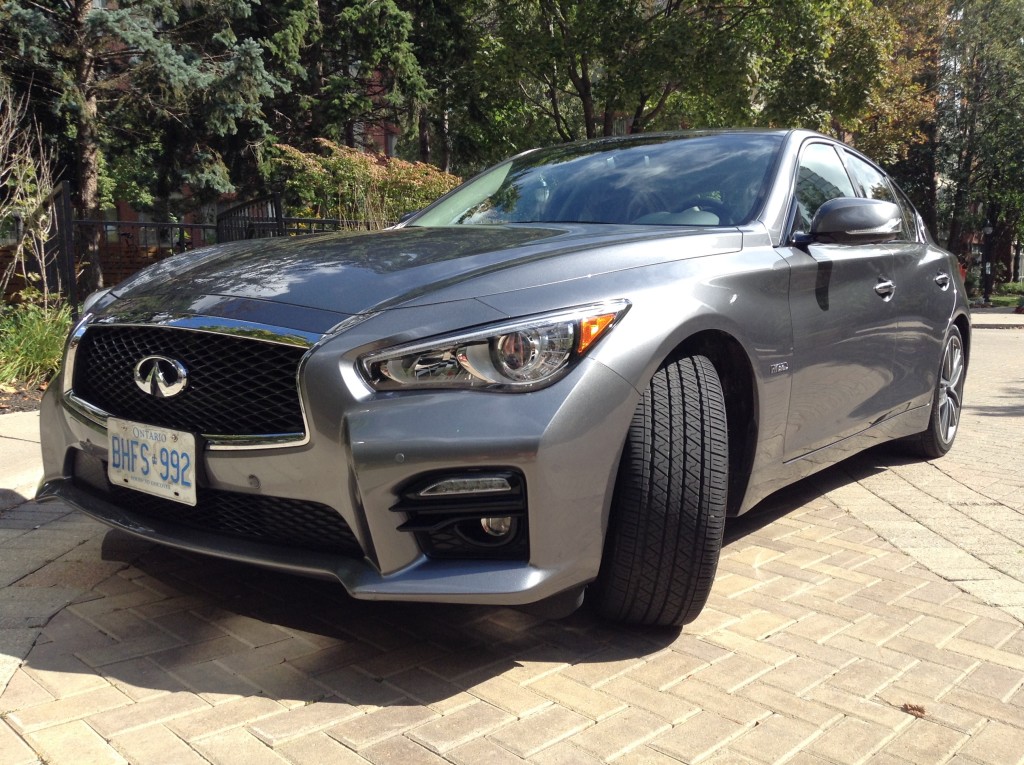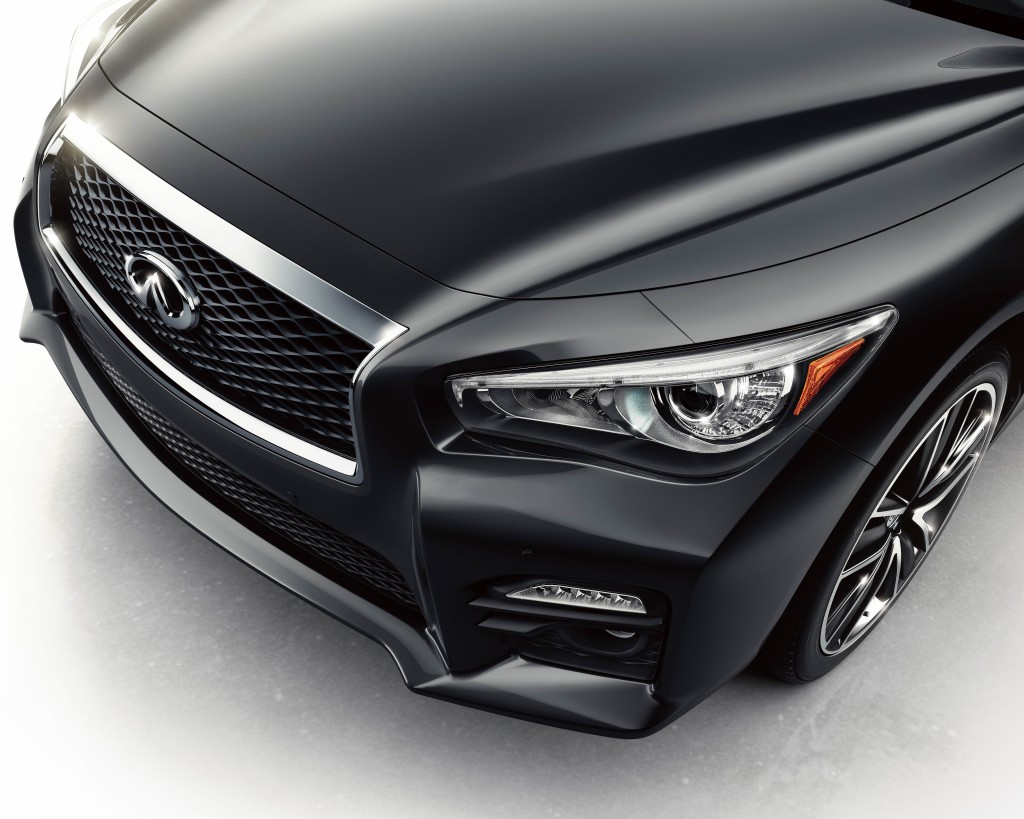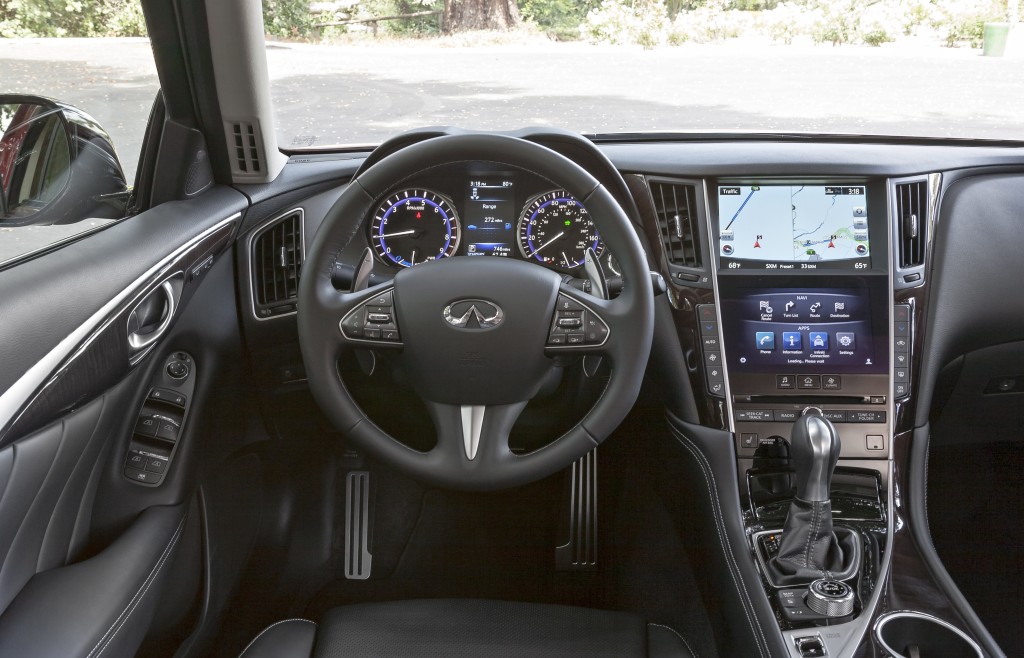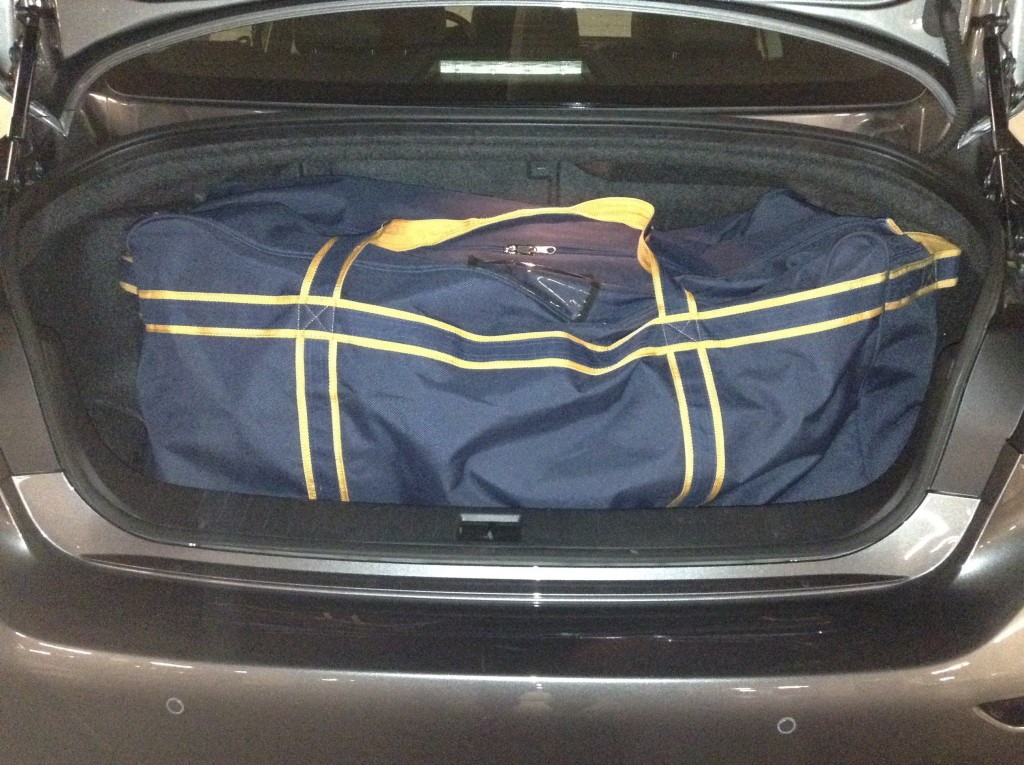On the highway in the suburbs west of Toronto, a pair of condominium towers draw drivers’ eyes south. They’re nicknamed the Marilyn Monroe towers thanks to pleasing curves you wouldn’t expect on structures that tall.
Similar thoughts about curves struck me when I picked up the 2015 Infiniti Q50S Hybrid for a week’s driving pleasure.
First impressions
The Q50’s body throws more curves at onlookers than a pro baseball team’s starting rotation. Or at least more than the typical sedan, luxury or not. Even the stoic Asgard Grey body colour on my tester couldn’t mask the lines that draw the eye from one end of the car to the other.
Seemingly needless curves draw the eye from their origins at the edges of the Infiniti’s massive front grill, itself a waved mesh pattern surface bordered by chrome. These curves run right to the base of the A-pillars.
Similar curves start along the top edges of the headlights and stretch along the sides of the car, nearly reaching the trunk lid. Just before these lines gracefully curve into the rear doors, another set of lines emerge under them, helping shape the car’s rear haunches. This zaftig shape manages to stay sleek thanks to the overall length of the sedan.
Infiniti seems to stress the shape of the Q50 so much that it made the sizeable disc brakes on all four wheels the same metallic grey colour as the wheels themselves.
Designers snuck in a few performance car styling cues. Dual chrome exhaust finishers poke out from under the rear bumpers. The lower front fascia edge is not dissimilar to the front “wing” of a race car. The overall design encourages better airflow around the car. Infiniti claims a drag coefficient of 0.26 (0.27/0.28 for Sport RWD/AWD models).
Interior
Infinit creates a richly textured visual feast using leather, maple wood accents, “Kacchu” finish aluminum trim and piano black surfaces. The show starts as doors open to reveal Infiniti-branded aluminum sill plates. Aluminum accented pedals contrast against the dark carpeting below.
Once seated, drivers get a luxurious view of the technology at their command.
Front passengers can more easily appreciate the design. They face a relatively simple cocoon consisting of a rounded dash merging with leather and maple on both sides.
The eight-way power drivers seat sits well back from the steering wheel. Start the Q50S and the seat moves to where it was when the car’s engine was last stopped. The only thing that doesn’t move is the manual thigh extension.
Stop the engine, open the door, and the seat moves back to make it easier for the driver to exit the car. It manages to do this without unduly inconveniencing the passenger sitting behind the driver.
Presets for two drivers can be tied to Infiniti’s Intelligent Key system. The car recognizes a key’s owner, and it goes beyond automatically moving the seat into the right configuration. It triggers preferences for things like heating, cooling, audio, navigation (if equipped) and telematics.
My head lightly touched the ceiling but I didn’t feel uncomfortably jammed in the driver’s seat. The power moonroof is a standard feature across the Q50 lineup. If it weren’t, I might not have noticed the ceiling at all.
Cargo capacity
The Q50’s trunk easily held my hockey bag, as well as a few small items around it.
The rear seats don’t fold down. Infiniti stores this hybrid’s battery between the rear seat and the trunk. It’s a cleaner look than the battery bump that makes trunk floors uneven in other hybrids.
In-car technology
Infiniti provides access to a comprehensive suite of in-car technology via two touch screens (8” and 7”) and a knob/joystick/button controller just below them. Infiniti calls its version of this device the Infiniti Controller. It isn’t quite as common as a radio volume knob, but it is nearly that easy to figure out.
Infiniti designer thoughtful touch #573: Infiniti put a “back” button on the steering wheel near controls used to navigate through audio choices. This one button is NOT common on many vehicles, and it makes plenty of sense on the wheel.
A third screen on the dash provides telematics and other brief snippets of information.
The upper touchscreen serves mainly as a navigation system display. The lower touchscreen provides control over the plethora of settings and features (entertainment, convenience, safety, etc.) that make up Infiniti’s InTouch system, as well as the Infiniti Studio on Wheels by Bose® Premium Audio system, which drives 14 speakers.
The system isn’t difficult to navigate, but it suffers shortcomings when I deal with content on my iPod Touch. This isn’t a criticism of Infiniti. I just don’t believe they can create the robust interface I would expect. The only companies that can solve those shortcomings, in my humble opinion, are:
- smartphone operating system developers (i.e. Apple and Google)
- developers of the applications that provide content that’s usable in cars. (If developers treat cars like just one other interface, the same as computers, phones, tablets and watches, I’d expect more people could enjoy their applications while driving and using Apple- or Google-developed and controlled interfaces.)
Active safety technology
It’s difficult to get into trouble driving the Q50. Put the car in reverse and
the Around View ® monitor with Moving Object Detection takes over the top screen.
The Q50S splits the screen like so:
- Half of the screen shows a rearview monitor.
- The other half shows the ground all round the car, extending several feet out, as well as the angle of the front wheels.
Driving
The Q50 powers all four wheels using Infiniti’s Direct Response Hybrid® System with Intelligent Dual Clutch Control. The hybrid system combines:
- a 3.5-litre 24- valve DOHC aluminum-alloy V6 that puts out 302 horsepower and 258 lb-ft of torque
- a 50 kW electric motor that contributes 67 horsepower and 214 lb-ft of torque
The car as a whole produces 360 net horsepower. Under hard acceleration, the Q50S puts both the gas and electric motors to work. Passing slower vehicles is never a problem in this car.
It fairly relaxes at highway speeds, keeping the cabin luxuriously quiet. In fact, it sometimes relaxes so much the electric engine kicks in. You might expect this more in stop-and-go traffic, but even at the highway limit the tachometer read zero rpm for short stretches every now and then.
The automatic transmission lets drivers go through its seven gears manually using either the gearshift lever or solid magnesium paddle shifters. Expect fans of the Infiniti-Red Bull Racing Formula One team to opt for the latter.
The Q50S steers by wire, forgoing traditional mechanical linkages between the front wheels and the steering wheel. I have read complaints about the “feel” of the steering, but there’s an upside to this design: Direct Adaptive Steering. This allows independent control of the Q50’s tire angle and steering inputs. Infiniti claims this system transmits the driver’s intentions to the wheels faster than a mechanical system. This allows Infiniti to add safety features like Lane Departure Prevention with Active Lane Control™. The upshot: the car helps drivers stay in their lane, which may make driving a little safer and less tiring.
The Q50 offers five drive modes, collectively known as the Infiniti InTuition™ System. These modes are Snow, Eco, Standard, Sport and Personal. They’re accessible using a switch by the drivers right thigh. Each mode consists of specific settings for the engine, suspension and steering (when equipped with Infiniti Direct Adaptive Steering™).
Safety
The Q50S’s active safety technology toolbox is impressive. I went through some of the touchscreen-related features above. Off-screen, the Infiniti also offers forward collision warnings, electronic brake force distribution and brake assist, as well as a full complement of passive-safety features.
One of my favourite technologies involves creating awareness where drivers’ eyes all too rarely go. Lights at the base of each A-pillar glow amber when another vehicle is in the Q50’s blind spot. Activate your turn signal and the car adds beeping to the lights. Lane departure warnings also beep at Q50-driving ruffians who would dare to change lanes without signalling their intentions beforehand. As with other systems I’ve tried, the system doesn’t always recognize faded lane markers, but it worked much of the time.
Fuel economy
The electric motor spares drivers from the thirst of its powerful V6 partner. The published numbers (L/100km):
- City: 8.7
- Highway: 7.5
- Combined: 8.2
Conclusion
A stately car that throws unexpected curves at onlookers, the Q50S Hybrid will also handle any unexpected curves a road throws at its driver. Drive this sports sedan calmly or put it through its paces. Either way, it will meet the expectations of demanding drivers.




